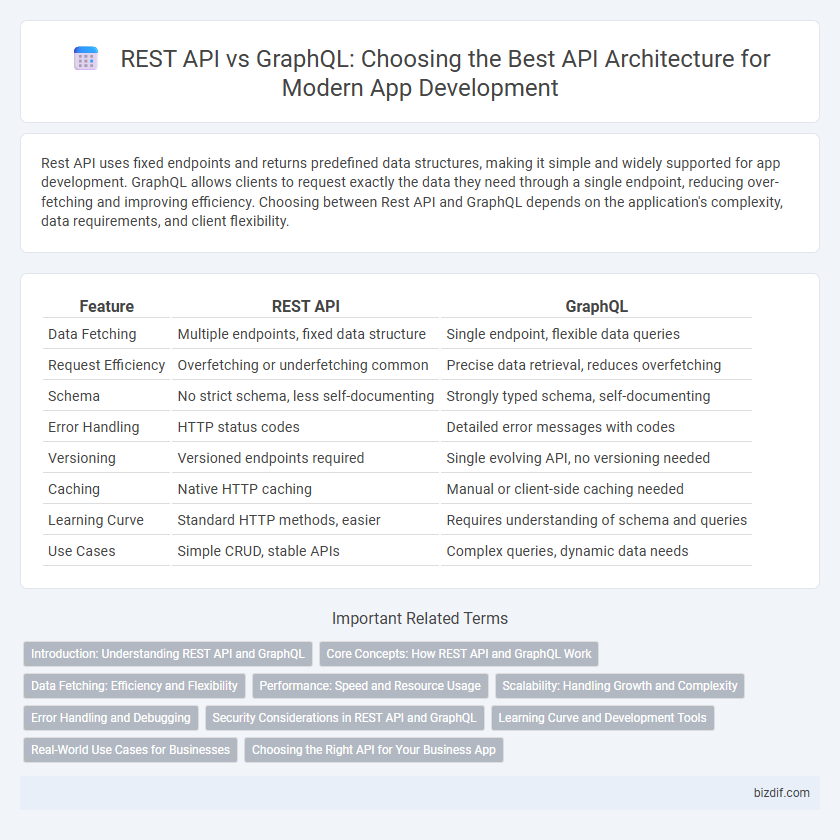Rest API uses fixed endpoints and returns predefined data structures, making it simple and widely supported for app development. GraphQL allows clients to request exactly the data they need through a single endpoint, reducing over-fetching and improving efficiency. Choosing between Rest API and GraphQL depends on the application's complexity, data requirements, and client flexibility.
Table of Comparison
| Feature | REST API | GraphQL |
|---|---|---|
| Data Fetching | Multiple endpoints, fixed data structure | Single endpoint, flexible data queries |
| Request Efficiency | Overfetching or underfetching common | Precise data retrieval, reduces overfetching |
| Schema | No strict schema, less self-documenting | Strongly typed schema, self-documenting |
| Error Handling | HTTP status codes | Detailed error messages with codes |
| Versioning | Versioned endpoints required | Single evolving API, no versioning needed |
| Caching | Native HTTP caching | Manual or client-side caching needed |
| Learning Curve | Standard HTTP methods, easier | Requires understanding of schema and queries |
| Use Cases | Simple CRUD, stable APIs | Complex queries, dynamic data needs |
Introduction: Understanding REST API and GraphQL
REST API operates through predefined endpoints and HTTP methods, enabling resource-based interactions that follow a client-server architecture. GraphQL offers a flexible query language allowing clients to request exactly the data they need from a single endpoint, reducing over-fetching and under-fetching issues. Understanding these core differences is essential for making informed decisions in modern app development and API design.
Core Concepts: How REST API and GraphQL Work
REST API operates by exposing discrete endpoints representing resources, with clients making HTTP requests using standard methods like GET, POST, PUT, and DELETE to interact with server data. GraphQL functions through a single endpoint where clients send queries defining the precise shape and fields of the data needed, enabling more efficient and flexible data retrieval. REST's resource-based architecture contrasts with GraphQL's schema-driven approach, allowing granular control over returned data and reducing over-fetching or under-fetching issues.
Data Fetching: Efficiency and Flexibility
GraphQL offers more efficient data fetching by allowing clients to request exactly the data they need, reducing over-fetching and under-fetching common in REST APIs. REST APIs require multiple endpoints for different data structures, leading to increased network requests and latency. GraphQL's flexibility in querying nested and relational data in a single request optimizes performance and reduces server load.
Performance: Speed and Resource Usage
Rest API typically involves multiple endpoints and over-fetching of data, which can increase response times and consume more bandwidth. GraphQL enables clients to request exactly the data needed in a single query, reducing payload size and improving response speed. This precise data retrieval in GraphQL leads to more efficient resource usage and faster performance for complex applications.
Scalability: Handling Growth and Complexity
GraphQL enhances scalability by allowing clients to request only the data they need, reducing over-fetching and under-fetching issues typical in REST APIs. REST APIs can struggle with complex queries and nested data retrieval, often requiring multiple endpoints and requests, which increases server load and latency. As applications grow in complexity, GraphQL's single endpoint and flexible query structure streamline data management, improving performance and scalability for large-scale app development.
Error Handling and Debugging
REST API error handling typically relies on standard HTTP status codes and verbose error messages, which can simplify tracing issues through clear, consistent responses. GraphQL offers more granular error reporting by returning detailed error objects alongside successful data, enabling precise debugging of partial failures within a single request. Effective debugging in GraphQL benefits from tools like Apollo Client and GraphiQL, which provide real-time query analysis and error insights, surpassing traditional REST debugging capabilities.
Security Considerations in REST API and GraphQL
REST API security relies heavily on standard HTTP measures such as HTTPS, OAuth, and API keys to control access and protect data. GraphQL presents unique security challenges, including query complexity and injection risks, which require implementing depth limiting, query whitelisting, and validation rules to mitigate attacks. Both APIs benefit from robust authentication, authorization frameworks, and monitoring to ensure secure data interactions in app development.
Learning Curve and Development Tools
Rest API offers a gentler learning curve due to its straightforward request-response architecture and wide adoption, supported by mature development tools and extensive documentation. GraphQL requires understanding query language syntax and schema design, but it benefits from powerful development tools like GraphiQL and Apollo Studio that facilitate efficient query testing and schema introspection. Choosing between Rest API and GraphQL depends on the team's expertise and project requirements, with Rest being easier to adopt initially and GraphQL offering advanced tooling for complex data fetching.
Real-World Use Cases for Businesses
Rest API remains the preferred choice for businesses managing standardized, resource-based workflows such as e-commerce platforms and content management systems, due to its simplicity and wide adoption. GraphQL excels in applications requiring flexible data retrieval and efficient client-server interactions, such as social media apps and dashboards, by minimizing over-fetching and under-fetching of data. Enterprises benefit from leveraging GraphQL for complex querying needs while maintaining Rest API for legacy integrations and straightforward operations.
Choosing the Right API for Your Business App
Selecting the right API for your business app hinges on factors like data requirements, query flexibility, and performance needs. REST APIs offer a straightforward, stateless approach ideal for simple, resource-based interactions, while GraphQL provides efficient data fetching tailored for complex, nested queries and variable client needs. Evaluating the volume of data, frequency of updates, and frontend requirements ensures optimal API selection to enhance app scalability and user experience.
Rest API vs GraphQL Infographic

 bizdif.com
bizdif.com